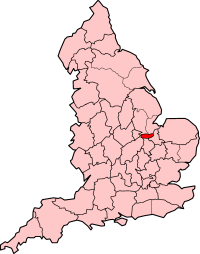Soke of Peterborough
| Soke of Peterborough | |
|---|---|
 |
|
| Population | |
| • 1901 | 41,122 |
| • 1961 | 74,758 |
| History | |
| • Created | 1889 |
| • Abolished | 1965 |
| • Succeeded by | Huntingdon and Peterborough |
| Status | Administrative county |
| • HQ | Peterborough |
| • Motto | Cor Unum (One Heart) |
 |
|
The Soke of Peterborough is an historic area of England associated with the City and Diocese of Peterborough, but considered part of Northamptonshire. The Soke was also described as the Liberty of Peterborough, or Nassaburgh hundred, and comprised, besides Peterborough, about thirty parishes.
Presently, the area forms much of the City of Peterborough in Cambridgeshire. The Church of England, however, still describes the diocese as consisting of Northamptonshire, Rutland and the Soke of Peterborough, i.e. that part of the city north of the River Nene.
In the Saxon period, the lord of the hundred had the power, or liberty, of holding a court and administering justice within its boundaries, and this system was subsequently continued by the Abbots of Peterborough, who either enforced in person, as lords, the observance of the ancient socage laws and customs, or appointed a deputy to act for them. On the establishment of Quarter Sessions in 1349, the separate jurisdiction of the Soke was still maintained as distinct from that of the county of Northampton; and, except for parliamentary purposes and matters relating to the militia, it was entirely independent of that county. Quarter Sessions for the liberty were held at the Sessions House in Peterborough, and petty sessions at the same place.
The civil government of the liberty was vested in the Marquess of Exeter, as Lord Paramount of Peterborough and custos rotulorum; around 40 magistrates appointed by the crown; and a high bailiff of the city appointed by the dean and chapter of Peterborough Cathedral. The Soke had its own magistrates, who were appointed by the Lord Paramount, acting under a commission of oyer and terminer, and gaol delivery, as well as under the ordinary commission, and the magistrates for the liberty retained the power of hanging a criminal in cases of murder, which in fact they exercised so late as the year 1812. The Local Jurisdictions Act 1820, though giving the liberty bench the power to commit (for murder only) to the county Assizes, did not abridge their full rights of gaol delivery. The Soke had also a separate rate, out of which all payments were made, and a separate police force, the Liberty of Peterborough Constabulary, appointed by and under the control of the magistrates of the Soke. In 1874, the City of Peterborough was granted a Charter of Incorporation and the new council was required to appoint a Watch Committee and constabulary, the Peterborough City Police. The two forces were eventually amalgamated in 1947 to form the Peterborough Combined Police Force.
...
Wikipedia
